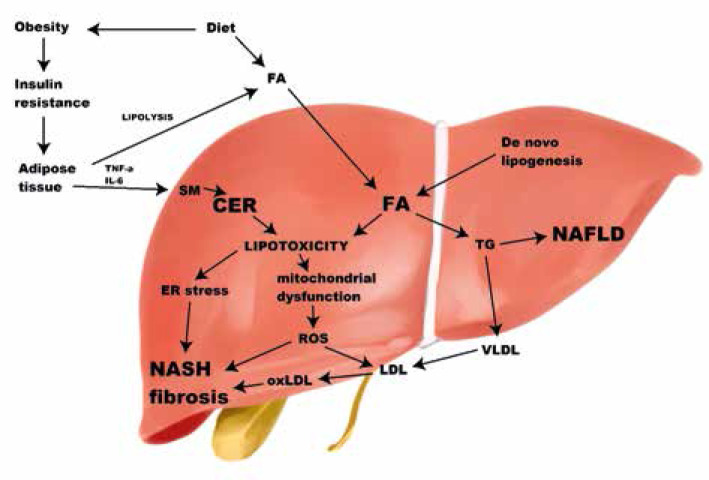Fig. 1.
Lipid classes and their role in development of non-alcoholic fatty liver disease and lipotoxicity. Obesity leads to insulin resistance, which is strongly linked to non-alcoholic fatty liver disease (NAFLD). In the insulin resistant state, circulating fatty acids are high, because of impaired anti-lipolytic action of insulin. Hepatic fatty acids (FA) derive from plasma, de novo lipogenesis or are released from lysosomes. An excessive amount of FA can be either incorporated into triglycerides or take part in a process of lipotoxicity. It seems that despite being responsible for liver steatosis, triglycerides play a protective role against liver injury. Ceramides can derive from FA, converted from sphingomyelin or sphingoid bases in lysosomes. Conversion from sphingomyelin is stimulated by inflammatory cytokines (TNF-α, IL-6). Both ceramides and FA are lipotoxic – they cause endoplasmic reticulum stress, mitochondrial dysfunction, and oxidative stress, and lead to increased synthesis of reactive oxygen species that take part in oxLDL synthesis. These processes increase inflammation, leading to non-alcoholic steatohepatitis, and promote fibrosis. FA – fatty acids, TNF-α – tumor necrosis factor α, IL-6 – interleukin 6, SM – sphingomyelin, NAFLD – non-alcoholic fatty liver disease, ROS – reactive oxygen species, TG – triglycerides, VLDL – very-low-density lipoprotein, LDL – low-density lipoprotein, oxLDL – oxidized low-density lipoprotein, NASH – non-alcoholic steatohepatitis

